Foods of War: Sh*t on a Shingle
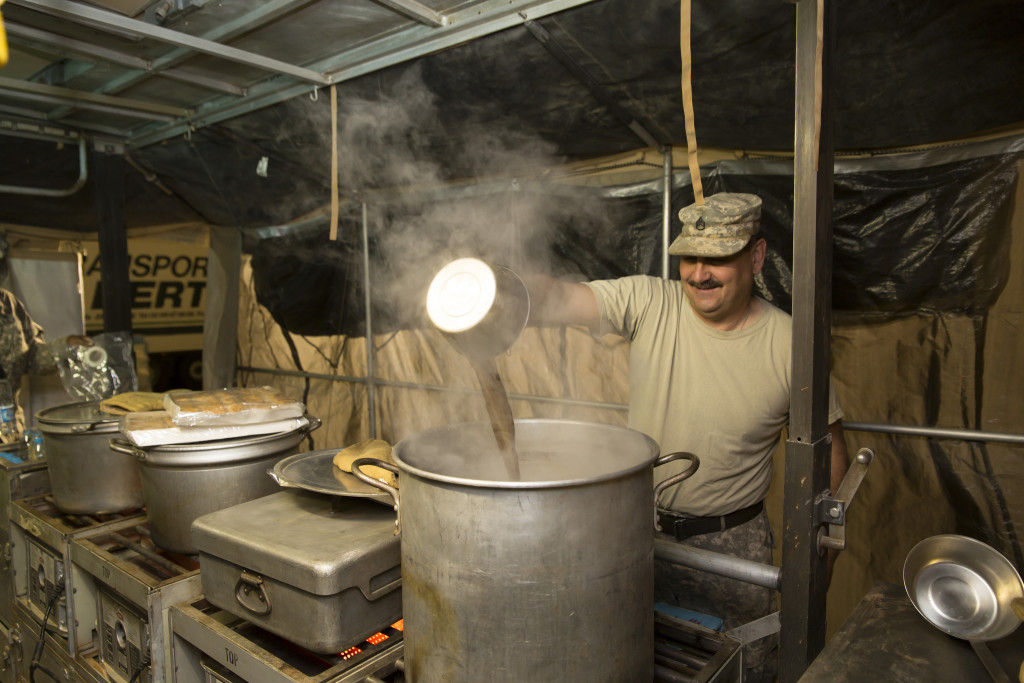
Editor’s note: This is the second piece in our series “Foods of War.” The intention is to examine the historicity behind different rations and meals served to soldiers and sailors over the years, and see if their reputations are deserved. Finally, since it wouldn’t be a Molotov Cocktail article without some element of drinking, we’ll incorporate a drink pairing, principally so that we’ve got something to wash it all down. Keep an eye out for future posts, and cheers!
“It’s an institution as closely linked with the Army as parades, pressed uniforms or highly shined boots.”
— Maj. Kevin Born, U.S. Army Quartermaster, on S.O.S
During my time as a naïve undergraduate, I remember walking into my dorm room’s kitchen after a night of excess to the sight of my roommate concocting an unfamiliar dish. It was definitely beef-based, but as I saw him add butter, flour, and milk to create an off-white sauce, my interest was piqued.
I politely inquired “What’s that?”
“S.O.S.” was his reply.
“S.O.S.?” I responded.
“Yeah, Shit on a Shingle. My Dad was an Army brat and grew up on the stuff.”
What also struck me about the scene was that there was actual culinary technique being employed. The dish, while humble, seemed eons beyond my cooking ability at the time, which largely focused on boiling pasta and the subsequent application of a liberal amount of jarred tomato sauce. In short, I didn’t know what I was looking at but I knew I liked it.
From that point on I had to know more. Not being from a military family I had no context for this mysterious and exotic dish. Some hasty Internet research revealed that almost anyone who grew up in a military family or had a parent who served had fond memories of this simple dish. Over the years there have been many riffs on the dish’s name: from Shit on a Shingle, to Save our Stomachs, to Same Old Stuff. These names reflect the love-hate relationship that many servicemembers and veterans have for the dish. Truthfully, S.O.S. tastes pretty good. It’s filling, salty, meaty, and satisfying (it certainly beats hardtack), but I could see it becoming dreadfully boring if consumed everyday.
S.O.S.’s origins are a bit unclear. Marine Corp lore traces the dish back to World War I, when an Army field kitchen was unable to keep up with the rapidly advancing Marine Brigade. As such, the brigade’s dinner of creamed beef didn’t arrive until the following morning, when the first sergeant ordered that the meal be served on dry bread. While this tale is interesting and entertaining, it is likely apocryphal. The dish appears in the Manual of Army Cooks from 1910, predating U.S. involvement in the first World War by seven years. The Navy has its own version, although its recipe is a bit more refined, namely due to the inclusion of tomatoes (along with other fresh veg), fresh ground beef, and nutmeg.
The first published recipe for S.O.S is the Army version, which calls for chipped beef, a dried meat product perfectly designed for the battlefield. Indeed, the version of S.O.S. in the Manual for Army Cooks, 1910 also uses evaporated milk, which would have been easier to transport, shelf stable, and (at the time) safer to consume than fresh milk. In fact, in a pinch the entire dish can be made from the pantry if fresh butter is removed in favor of a more shelf-stable fat (such as lard) and beef stock is substituted with water.
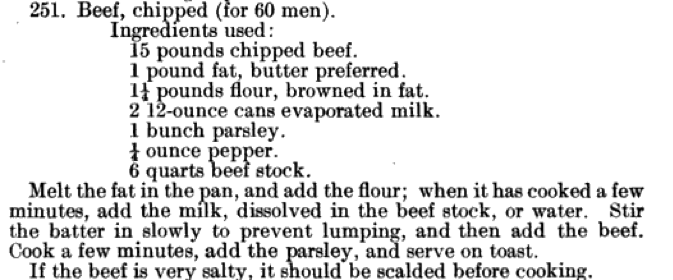
As the recipe suggests, S.O.S. is less of a dish and more of a rubric: Make a sauce, add meat of some type, and serve over bread. In this light, the dish fits into the same culinary genre as the southern staple biscuits and gravy, or even the British classic beans on toast. While S.O.S still has a place in the culinary lexicon of our armed forces, from a practical standpoint the dish is probably more useful after a night on the town.
Despite the dish’s unglamorous name, appearance, and origins, its culinary roots are actually quite French. The soul of S.O.S. is essentially a classic Béchamel, one of Auguste Escoffier’s five mother sauces. As such, the dish’s construction begins with a roux comprised of equal parts fat (in this case butter) and flour. From here, milk is added and the sauce thickens until it is smooth and coats the back of a spoon. From this point you can serve as is or add cheese (for a Mornay), onions (for a Soubise), or mustard (for a, you guessed it, Mustard Sauce). Easy to see why they call it a mother sauce, no?
The following recipe keeps it simple with a semi-classic Béchamel (the stock could be omitted for an equal portion of milk) and pays homage to the original Army 1910 version but is scaled down to serve two people (or one, after an especially debaucherous night out):
Recipe
4 oz butter
4 tbsp flour
1 cup milk
1 cup beef stock
3 oz package of chipped beef, cut into about 1 inch ribbons
2 slices of white bread
Black pepper to taste
Chives (optional)
Cut chipped beef into ribbons.
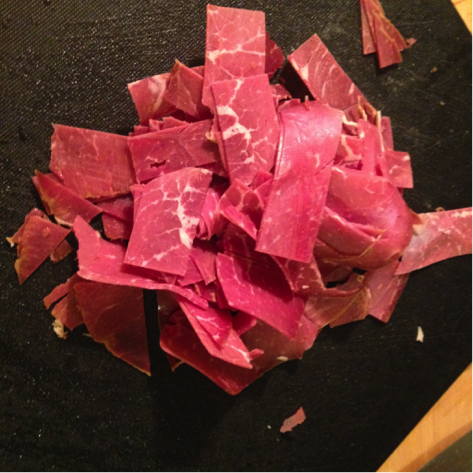
Over medium high heat, sear the beef for about 2 mins. Remove from the pan and put to the side. Toast 2 slices of white bread.
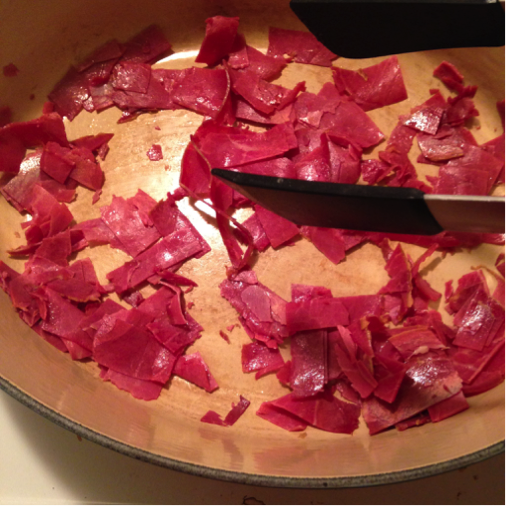
In the same skillet as you seared the beef, melt the butter. Once melted, whisk in the flour a bit at a time, taking care not to let it clump. This is your roux.

Once the roux gets a bit bubbly (about five minutes), whisk in the milk and beef stock.
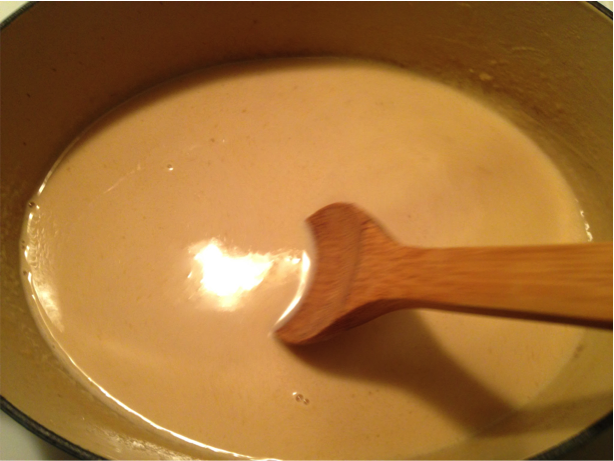
The sauce should thicken in 5-10 minutes. Add the beef to heat through and crack in 2-3 good grinds of black pepper.
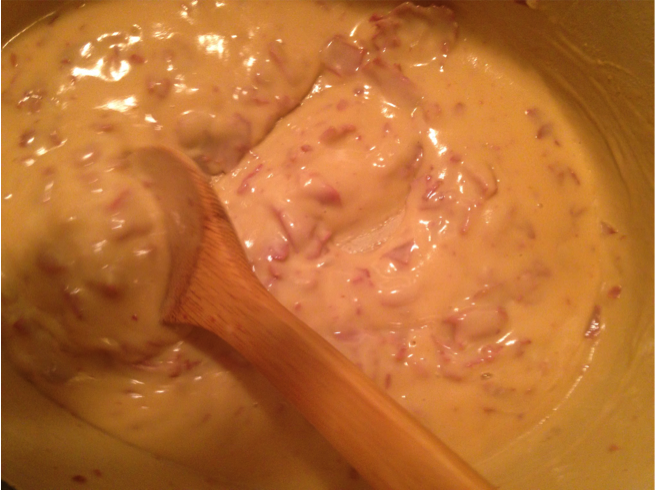
Plate the toast and pour the creamed chipped beef evenly over your “shingles.” Garnish with some finely chopped chives and enjoy with a fork and knife.

Drink Pairing
When I decided to make S.O.S., my initial thought was to pair it with something historically appropriate that American G.I.s could have developed a taste for while in France, ergo brandy or cognac made sense. However upon further consideration, it seemed that in our modern era this dish is far more likely to be consumed either before or after a night of significant imbibing. For the former, the ideal pairing would of course be water (if you’re thirsty, you’ve lost the battle). For the latter scenario though, there can only be one suitable paring: the Bloody Mary. The acidity, the spicy punch, the…vodka — all of these ingredients make this cocktail the perfect companion for the unctuous, salty goodness of S.O.S.
I should preface the recipe with a note about the Blood Mary. This drink deserves an article all its own, but in short, the Bloody has reached its nadir in our drinking culture. From the “make your own” Bloody Mary bar, to its central role in the bottomless brunch, a once magical beverage has been lowered to slop buckets full of chunky mix carelessly combined with rail vodka. Furthermore, the proclivity of bars to serve the drink in a pint glass leaves the drinker with a watery drink that warms before it can be finished. The recipe below brings the noble Bloody Mary back to craft cocktail status.
3 oz tomato juice
2 oz vodka
1 oz olive juice/brine
1 tsp horseradish
½ tsp Sriracha
Garnish with celery stalk, olive, and lime wheel
Combine all ingredients, excluding garnishes, in a Boston shaker with ice. Shake vigorously. Strain into a Collins glass with ice, garnish and enjoy, Milwaukee style, with a pony beer chaser.

So there you have it, a meal and a drink that when paired together can vanquish all but the worst aftermath of over consumption. While its origins are murky and its exact formulation contested, S.O.S. should be thought of as an approach rather than a recipe. In that spirit, the aspiring Army cook should embody American “can-do,” and shouldn’t be dissuaded from using what they have on hand (ham, pork sausage, or chicken thighs would all work well). While your cardiologist may disagree, I encourage you to do your duty as an American, and embrace the dish that has filled the bellies of our service members and their families for generations. S.O.S is the rarest breed of military ration — one that actually tastes good.
James Sheehan is a homebrewer and cider-maker. When he’s not fermenting things he works for a Washington, D.C. based democracy education non-profit. He holds an MA in Terrorism, Security, and Society from King’s College, London.
Photo credit: The National Guard

